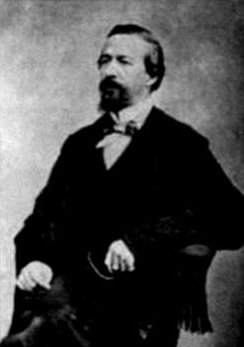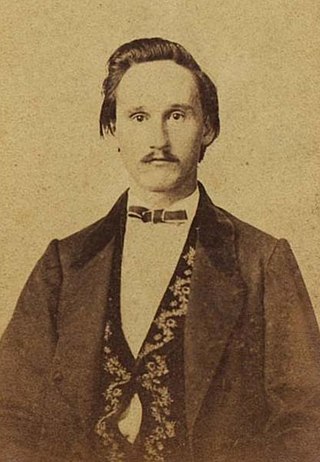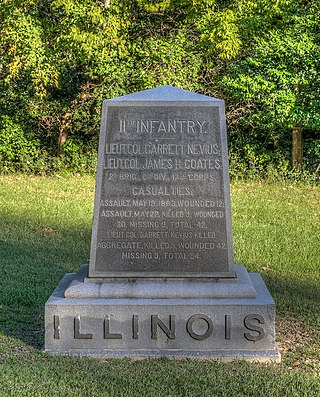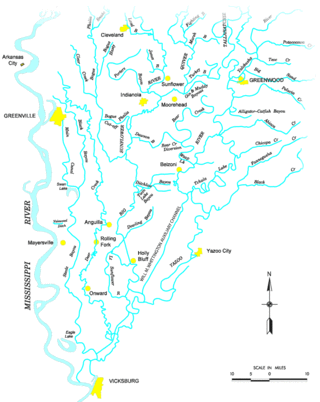
William Wirt Adams (1819–1888) was a banker, planter, state legislator, and a Brigadier General in the Confederate States Army.

The 2nd Tennessee Cavalry Regiment, also known as the 22nd Tennessee Cavalry after it was consolidated with the 21st Tennessee Cavalry (Wilson’s), was a cavalry unit of the Confederate States of America during the American Civil War, organized on June 12, 1862. The unit was originally commanded by Lieutenant-Colonel Clark Russell Barteau, who was promoted from the rank of private on the day that he was placed in command of the new regiment. He was promoted to colonel a year later.

The 10th Arkansas Infantry (1861–1865) was a Confederate Army infantry regiment during the American Civil War from the state of Arkansas. The unit is also known as A. R. Witt's Infantry, C. M. Cargile's Infantry, E. L. Vaughan's Infantry, Thomas D. Merrick's Infantry, S. S. Ford's Infantry, Obed Patty's Infantry, George A. Merrick's Infantry, Zebulon Venable's Infantry and Robert C. Bertrand's Infantry in contemporary accounts. After being captured at the Siege of Port Hudson, the unit reorganized as a mounted infantry unit, and was known as the 10th Arkansas Cavalry Regiment or Witt's Arkansas Cavalry.
The 11th/17th Consolidated Arkansas Infantry (1861–1865) was a Confederate Army infantry regiment during the American Civil War. The unit is also known as the 11th/17th Arkansas Mounted Infantry or the 11th/17th Arkansas Cavalry. At various times after the consolidation, members of the unit who were captured gave their unit as either the 11th Arkansas Cavalry or the 17th Arkansas Cavalry.

The 11th Regiment Illinois Volunteer Infantry was an infantry regiment from Illinois that served in the Union Army during the American Civil War. In April 1861, it was formed as a three-month volunteer unit, and in July 1861 it was reorganized as a three-year unit, in which role it served until the end of the war. Two of its commanding officers were promoted to brigadier general and led major units during the war. In its first major action at Fort Donelson the regiment suffered terrible losses. The 11th Illinois also fought at Shiloh, Riggins Hill, Vicksburg, First Yazoo City, Second Yazoo City, and Fort Blakely. In April 1863, the 109th Illinois Infantry Regiment was disbanded and its enlisted men transferred into the 11th Illinois. The regiment was mustered out of service in July 1865.

The Yazoo City expedition was an expedition of Union forces from the Vicksburg garrison under General John McArthur against Confederate forces in central Mississippi under General Wirt Adams.
The Monticello Artillery (1862–1865) was a Confederate Army artillery battery during the American Civil War. The unit was also known as: Owen's Battery, or Howell's Battery. Some post war records refer to the unit as the Drew Light Artillery because most original members were from Drew County, Arkansas.

The 27th Texas Cavalry Regiment, at times also known as Whitfield's Legion or 1st Texas Legion or 4th Texas Cavalry Battalion, was a unit of mounted volunteers that fought in the Confederate States Army during the American Civil War. First organized as the 4th Texas Cavalry Battalion or Whitfield's Legion, the unit served dismounted at Pea Ridge and First Corinth. Additional companies from Texas were added and the unit was upgraded to the 27th Texas Cavalry Regiment or 1st Texas Legion later in 1862. Still dismounted, the unit fought at Iuka and Second Corinth. The regiment was remounted and fought at Holly Springs in 1862, Thompson's Station in 1863, and at Yazoo City, Atlanta, Franklin, and Third Murfreesboro in 1864. The regiment surrendered to Federal forces in May 1865 and its remaining soldiers were paroled.
The Battle of Camp Davies was a skirmish during the American Civil War on November 22, 1863, near a Union Army camp about six miles south of Corinth, Mississippi. A 70-man detachment of the 1st Regiment Alabama Cavalry (Union), commanded by Major Francis L. Cramer, drove off a 150-man Confederate force of the 16th Battalion, Mississippi Cavalry State Troops, commanded by Major Thomas W. Ham, and killed at least 4 Confederate soldiers, while suffering two severely wounded troopers. This action is the only engagement recorded as occurring at or near Camp Davies in major sources on American Civil War battles. Other similar engagements in the vicinity of Corinth in 1863 may have occurred near Camp Davies.

The 3rd United States Colored Cavalry was a regiment in the United States Army organized as one of the units of the United States Colored Troops during the American Civil War. The regiment was originally formed in October 1863 at Vicksburg, Mississippi as the 1st Mississippi Cavalry Regiment. The unit soon began taking part in expeditions near Vicksburg. In February–March 1864, the regiment saw action at Yazoo City. After being renamed the 3rd U.S. Colored Cavalry in March 1864, the regiment continued to participate in raids, including the Yazoo City expedition in May. In December 1864, the unit took part in a successful raid led by Benjamin Grierson during which the Battle of Egypt Station and other actions were fought. The regiment operated near Memphis, Tennessee, until April 1865, after which it returned to Vicksburg for occupation duties. The soldiers were mustered out of federal service in January 1866.

The 2nd Louisiana Cavalry Regiment was a unit of mounted volunteers recruited in Louisiana that fought in the Confederate States Army during the American Civil War. Breazeale's Cavalry Battalion was formed in July 1862 and was augmented by five additional companies in September 1862 to form a regiment. It served for the entire war west of the Mississippi River in the Trans-Mississippi Department. The regiment fought at Georgia Landing, Fort Bisland, Irish Bend, and Brashear City in 1863 and Henderson's Hill and Mansfield in 1864. Afterward, the regiment fought in minor skirmishes before the Trans-Mississippi's final surrender on 26 May 1865.

The 12th Louisiana Infantry Regiment was a unit of volunteers recruited in Louisiana that fought in the Confederate States Army during the American Civil War. Formed in August 1861, the regiment served in the Western Theater of the American Civil War and was unique in that there were 12 companies. The regiment garrisoned Island Number Ten before being stationed at Fort Pillow. It fought at Second Corinth in 1862 and Champion Hill and Jackson in 1863. A detachment served during the Siege of Vicksburg and was captured. In 1864, the regiment fought in the Meridian, Atlanta, and Franklin–Nashville campaigns, suffering heavy losses at Peachtree Creek and Franklin. It fought at Bentonville in 1865 before surrendering with General Joseph E. Johnston.

The 20th Louisiana Infantry Regiment was a unit of volunteers recruited in Louisiana that fought in the Confederate States Army during the American Civil War. The unit began its existence as the 6th Louisiana Battalion in September 1861. The battalion was augmented to regimental strength in January 1862 at New Orleans and served during the war in the Western Theater of the American Civil War. The regiment fought at Shiloh, Farmington, and Perryville in 1862. After being reduced in numbers, the regiment was consolidated with the 13th Louisiana Infantry Regiment and served at Stones River, Jackson, Chickamauga, and Missionary Ridge in 1863. The 13th-20th Consolidated Louisiana fought at Resaca, New Hope Church, Ezra Church, and Nashville in 1864. The consolidation with the 13th Louisiana was discontinued in February 1865 and the regiment was re-consolidated with other units. It fought its final battle at Spanish Fort one month before surrendering in May 1865.
The 1st Battalion, Mississippi Mounted Rifles was a unit in the Union Army during the American Civil War, and was the only Union Mississippi unit created during the Civil War other than regiments of the United States Colored Troops
The 4th Mississippi Cavalry Regiment was a cavalry unit of the Confederate States Army in the Western Theater of the American Civil War. The 4th Regiment was formed by combining various cavalry companies into one consolidated regiment in the autumn of 1862. The 4th Cavalry fought in numerous battles in Mississippi and Louisiana before surrendering at the close of the war in May 1865.
The 38th Mississippi Infantry Regiment, later redesignated as the 38th Mississippi Mounted Infantry, was a unit of the Confederate States Army during the American Civil War. The regiment fought in numerous battles across Mississippi as an infantry unit, and in 1864 was reorganized as a mounted infantry regiment. As the 38th was assigned to a cavalry brigade after 1864, it is sometimes inaccurately referred to as the 38th Mississippi Cavalry, although this designation was never official.
The First Mississippi Cavalry Regiment was a unit of the Confederate States Army during the American Civil War. Originally designated the First Battalion Mississippi Cavalry, the unit was upgraded to a regiment in 1862, and fought in many battles of the Western theater of the American Civil War.
The 28th Mississippi Cavalry Regiment was a Confederate cavalry unit from Mississippi. The 28th Cavalry fought in numerous battles of the Western theater of the American Civil War before surrendering in Alabama on May 4, 1865.

The 1st Mississippi Light Artillery Regiment was a unit of the Confederate States Army from Mississippi. Formed in 1862, the regiment was sent to defend the strategic points of Vicksburg and Port Hudson along the Mississippi River. After the surrender of Confederate forces at Vicksburg on July 4, 1863, the various companies of the 1st Light Artillery were dispersed and saw action across the Western theater of the American Civil War, although they never operated as a combined regiment. The final remnants of these artillery batteries surrendered in April 1865 after the Battle of Fort Blakeley.
The 2nd Mississippi Cavalry Regiment was a unit of the Confederate States Army from Mississippi. Formed in the spring of 1862, the 2nd Cavalry took part in many battles of the western theater in Mississippi, Alabama, Georgia, and Tennessee before surrendering in April 1865.












